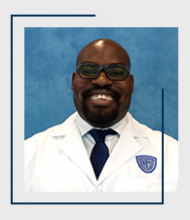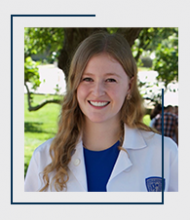Stories from the Classroom
Students from Prof. Susanne Wish-Baratz's class shared their personal experiences learning with the HoloAnatomy® Software Suite. The testimonials below discuss their thoughts on integrating HoloAnatomy® Software into the curriculum, how it improved their understanding of human anatomy, and how they believe hologram technology may advance the world of education in the future.
Razaq Duroduye
CWRU MSTP Student, Class of 2027
I wanted to become a doctor because I always wanted to learn how things work. My family experienced a lot of health issues, and wasn’t equipped with the knowledge to understand how to help those around me. So I began my journey at a community college, where the only anatomy courses available were restricted to those pursuing a degree in nursing. It was not until I began my four-year degree at CWRU that I had access to a higher level of anatomy education.
Making HoloAnatomy® Software available at an undergraduate level not only makes high quality anatomy education more available to everyone, but could really help students like me jumpstart their journey to become a doctor.
I would say that using HoloAnatomy® Software has improved my proficiency with anatomy to 150%. While doing cadaveric dissection, we spent four hours just cutting through all the layers of the body. Most of that time was spent just trying to get to the structures we needed to identify. That time was beneficial for gauging how things felt and understanding what different parts were, it was time that wasn’t spent actively learning. In conjunction with HoloLens, I can save time not having to cut through all the layers in order to get to a specific structure or system that I want.
Having the information presented in orthogonal way helps me put everything into better context. I was able to accelerate the time needed to identify and study the information that was clinically relevant to my exams.
Talia Burstein
CWRU Medical Student, Class of 2022
HoloAnatomy® Software extends my ability to integrate the new information I learn in classes over a longer period of time than if I were limited to time with a cadaver. During my dissection labs I had to assume I was following along correctly; you can’t sit in a cadaver lab with your laptop out! In the HoloAnatomy® Software Suite, everything is color-coded or labeled, so there is less confusion.
Using HoloAnatomy® Software as a visual reference makes it an invaluable resource when learning a lot of new information at once.
While some may argue that digital models look different from human bodies, cadavers too appear different from living human beings. And perhaps human cadavers could be even more beneficial for organ donation or furthering medical research.
The HoloAnatomy® Software Suite is a renewable resource that continues to develop. Imagine using HoloAnatomy® Software to help educate patients about their diagnoses and treatment options.
Yes, HoloAnatomy® Software is an investment, however it’s one that can not only be used for medical students, but also has broader possible applications for clinicians and patients as well.
Madeline Beckman
CWRU Medical Student, Class of 2022
With anatomy, there is no way to circumvent the amount of time you have to dedicate to learning what is essentially an entirely new language. Anatomy is a subject that requires daily practice, and HoloAnatomy® Software allowed me to do just that. HoloAnatomy® Software was a helpful tool for review when I did not have access to a cadaver lab. To study, I would pull up the unlabeled version of the model and quiz myself on the structures.
Though I had another 2D model I would use for review, the advantage of having the 3D composition in HoloAnatomy® Software was the ability to simultaneously see all the levels and layers of the human body, better than even in a human cadaver.
The first time I learned about HoloAnatomy® Software was when I was interviewing with the School of Medicine. They showed me a video, and the first thing I thought was “whoa, this is awesome.”
It was amazing how you could see the model from all directions, and the idea of a mixed model curriculum sparked interest.
In comparison to other technologies I had seen like the Sectra table, I was vastly more impressed with the HoloLens and the features available with HoloAnatomy® Software. If I didn’t have access to a cadaver lab, I would jumped at the opportunity to use the HoloAnatomy® Software Suite.
Dr. Sue Wish-Baratz
Associate Anatomy Professor
Case Western Reserve University School of Medicine
Cleveland, OH
My experience working with the HoloAnatomy® Software Suite program has always been fairly effortless. I would say creating a lecture with the Design Tool takes an equivalent amount of time to making a regular powerpoint presentation. Editing my lectures is very fast as well. Even the night before a morning lab, I am able to sit in a session with my teaching assistant, discuss the edits I would like to make, and watch the changes happen right in front of me. It’s as simple as making two clicks and publishing; it’s super easy.
The Remote Learning Experience
The COVID-19 pandemic struck in the middle of the spring 2020 semester, affecting many universities across the nation. The result was a forced and rapid transition from a tradition in-person teaching format, to a remote learning format.
Concerns arose regarding classes with lab sections. Would students be forced to retake their pre-requisite anatomy courses? Would the pandemic delay our students’ education?
At CWRU’s School of Medicine, the HoloAnatomy® Software Suite was already being utilized in anatomy education, allowing medical students continue their studies from home. With the use of a HoloLens device, students could continue holographic dissections from home.




